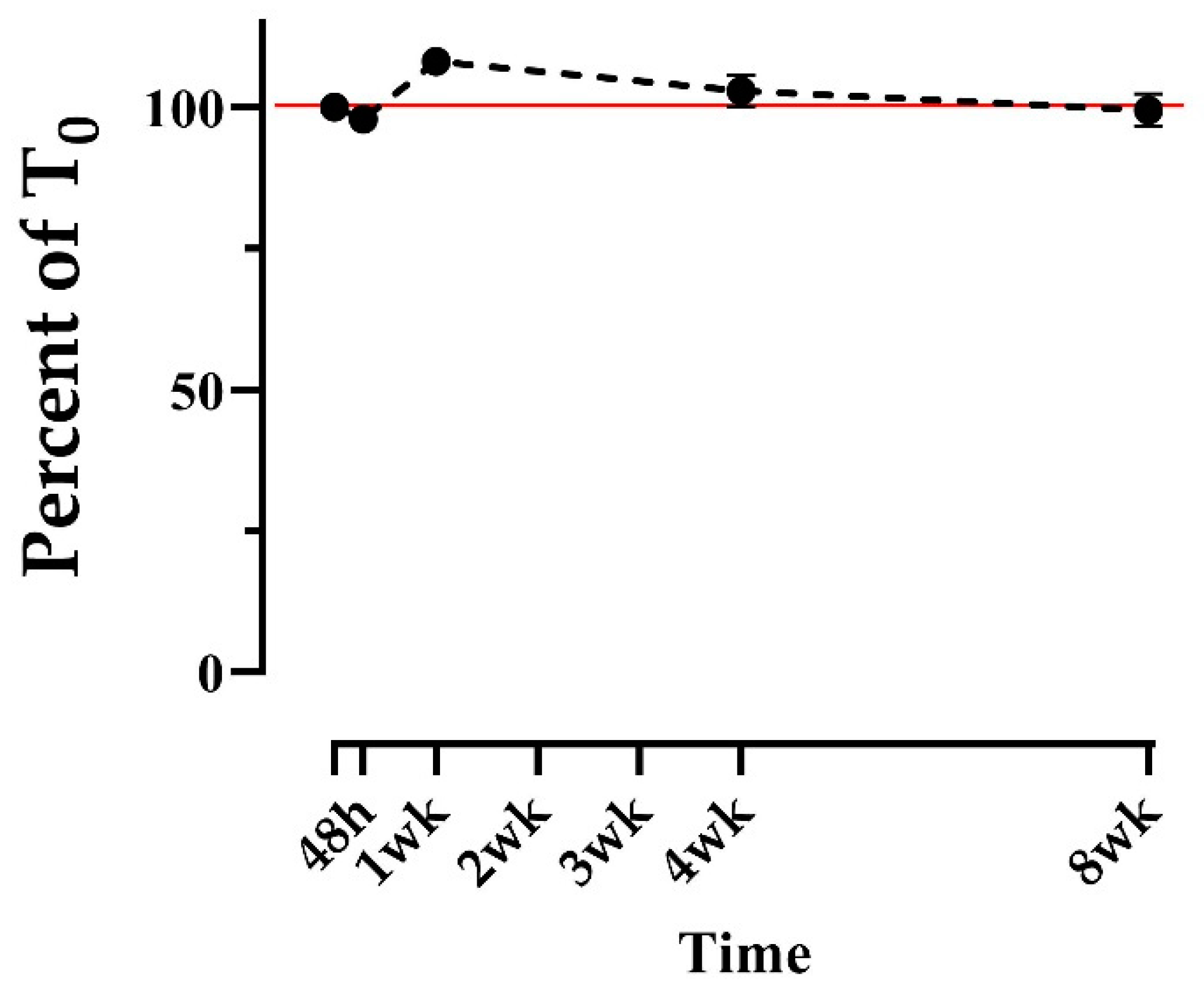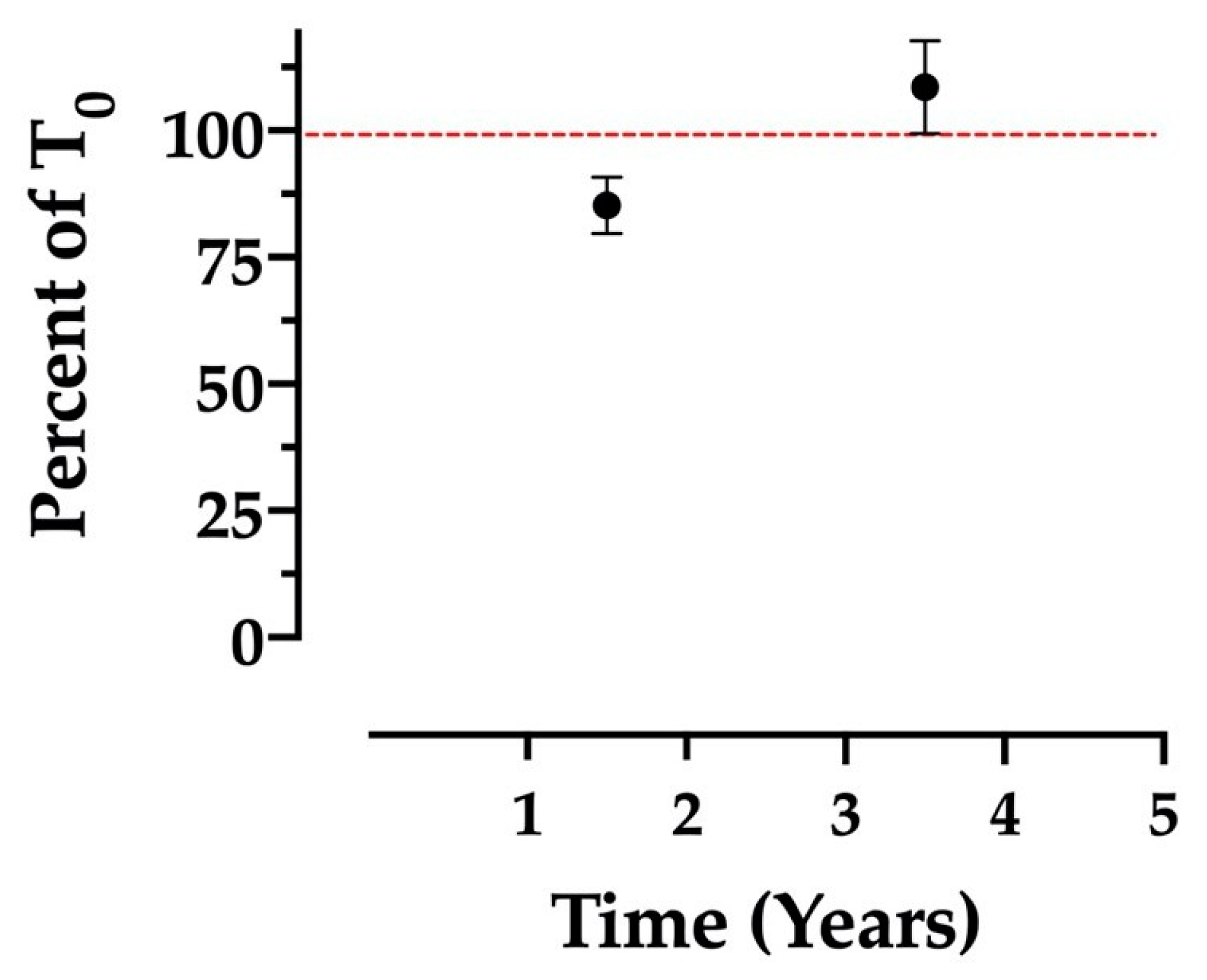Stability of Saxitoxin in 50% Methanol Fecal Extracts and Raw Feces from Bowhead Whales (Balaena mysticetus)
Abstract
:1. Introduction
2. Results and Discussion
2.1. Extract Group
2.2. Treatment Group
2.3. Long-Term Frozen Group
3. Materials and Methods
3.1. Sample Collection and Selection
3.2. Study Setup
3.3. Toxin Extraction
3.3.1. Extract Group
3.3.2. Treatment Group
3.4. Toxin Quantification
3.5. Data Analysis
4. Conclusions
Supplementary Materials
Author Contributions
Funding
Institutional Review Board Statement
Data Availability Statement
Acknowledgments
Conflicts of Interest
References
- Anderson, D.M.; Richlen, M.L.; Lefebvre, K.A. Harmful Algal Blooms in the Arctic. Arctic Report Card 2018. Available online: https://arctic.noaa.gov/Report-Card/Report-Card-2018/ArtMID/7878/ArticleID/789/Harmful-Algal-Blooms-in-the-Arctic (accessed on 7 April 2020).
- Etheridge, S.M. Paralytic Shellfish Poisoning: Seafood Safety and Human Health Perspectives. Toxicon 2010, 56, 108–122. [Google Scholar] [CrossRef] [PubMed]
- Lefebvre, K.A.; Quakenbush, L.; Frame, E.; Huntington, K.B.; Sheffield, G.; Stimmelmayr, R.; Bryan, A.; Kendrick, P.; Ziel, H.; Goldstein, T.; et al. Prevalence of Algal Toxins in Alaskan Marine Mammals Foraging in a Changing Arctic and Subarctic Environment. Harmful Algae 2016, 55, 13–24. [Google Scholar] [CrossRef] [PubMed]
- Cusick, K.; Sayler, G. An Overview on the Marine Neurotoxin, Saxitoxin: Genetics, Molecular Targets, Methods of Detection and Ecological Functions. Mar. Drugs 2013, 11, 991–1018. [Google Scholar] [CrossRef] [PubMed]
- Cestéle, S.; Catterall, W.A. Molecular Mechanisms of Neurotoxin Action on Voltage-Gated Sodium Channels. Biochimie 2000, 82, 883–892. [Google Scholar] [CrossRef]
- Kao, C.Y.; Nishiyama, A. Actions of Saxitoxin on Peripheral Neuromuscular Systems. J. Physiol. 1965, 180, 50–66. [Google Scholar] [PubMed]
- Landsberg, J.H.; Lefebvre, K.A.; Flewelling, L.J. Effects of Toxic Microalgae on Marine Organisms. In Toxins and Biologically Active Compounds from Microalgae; Rossini, G.P., Ed.; CRC Press: Boca Raton, FL, USA, 2014; Volume 2, pp. 379–449. [Google Scholar]
- Sommer, H.; Meyer, K.F. Paralytic Shellfish Poisoning. Arch. Pathol. Lab. Med. 1937, 24, 560–598. [Google Scholar]
- Hallegraeff, G.M. A Review of Harmful Algal Blooms and Their Apparent Global Increase. Phycologia 1993, 32, 79–99. [Google Scholar] [CrossRef]
- Van Hemert, C.; Schoen, S.K.; Litaker, R.W.; Smith, M.M.; Arimitsu, M.L.; Piatt, J.F.; Holland, W.C.; Ransom Hardison, D.; Pearce, J.M. Algal Toxins in Alaskan Seabirds: Evaluating the Role of Saxitoxin and Domoic Acid in a Large-Scale Die-off of Common Murres. Harmful Algae 2020, 92, 101730. [Google Scholar] [CrossRef]
- Lefebvre, K.A.; Fachon, E.; Bowers, E.K.; Kimmel, D.G.; Snyder, J.A.; Stimmelmayr, R.; Grebmeier, J.M.; Kibler, S.; Ransom Hardison, D.; Anderson, D.M.; et al. Paralytic Shellfish Toxins in Alaskan Arctic Food Webs during the Anomalously Warm Ocean Conditions of 2019 and Estimated Toxin Doses to Pacific Walruses and Bowhead Whales. Harmful Algae 2022, 114, 102205. [Google Scholar] [CrossRef]
- Anderson, D.M.; Alpermann, T.J.; Cembella, A.D.; Collos, Y.; Masseret, E.; Montresor, M. The Globally Distributed Genus Alexandrium: Multifaceted Roles in Marine Ecosystems and Impacts on Human Health. Harmful Algae 2012, 14, 10–35. [Google Scholar] [CrossRef]
- Natsuike, M.; Nagai, S.; Matsuno, K.; Saito, R.; Tsukazaki, C.; Yamaguchi, A.; Imai, I. Abundance and Distribution of Toxic Alexandrium tamarense Resting Cysts in the Sediments of the Chukchi Sea and the Eastern Bering Sea. Harmful Algae 2013, 27, 52–59. [Google Scholar] [CrossRef] [Green Version]
- Anderson, D.M.; Fachon, E.; Pickart, R.S.; Lin, P.; Fischer, A.D.; Richlen, M.L.; Uva, V.; Brosnahan, M.L.; McRaven, L.; Bahr, F.; et al. Evidence for Massive and Recurrent Toxic Blooms of Alexandrium catenella in the Alaskan Arctic. Proc. Natl. Acad. Sci. USA 2021, 118, e2107387118. [Google Scholar] [CrossRef] [PubMed]
- Natsuike, M.; Matsuno, K.; Hirawake, T.; Yamaguchi, A.; Nishino, S.; Imai, I. Possible Spreading of Toxic Alexandrium tamarense Blooms on the Chukchi Sea Shelf with the Inflow of Pacific Summer Water Due to Climatic Warming. Harmful Algae 2017, 61, 80–86. [Google Scholar] [CrossRef]
- Natsuike, M.; Saito, R.; Fujiwara, A.; Matsuno, K.; Yamaguchi, A.; Shiga, N.; Hirawake, T.; Kikuchi, T.; Nishino, S.; Imai, I. Evidence of Increased Toxic Alexandrium tamarense Dinoflagellate Blooms in the Eastern Bering Sea in the Summers of 2004 and 2005. PLoS ONE 2017, 12, e0188565. [Google Scholar] [CrossRef] [PubMed]
- Anderson, D.M. Toxic Algal Blooms and Red Tides: A Global Perspective. In Red Tides: Biology, Environmental Science, and Toxicology; Okaichi, T., Anderson, D.M., Nemoto, T., Eds.; Elsevier: New York, NY, USA, 1989. [Google Scholar]
- Costas, E.; Lopez-Rodas, V. Paralytic Phycotoxins in Monk Seal Mass Mortality. Vet. Rec. 1998, 142, 643–644. [Google Scholar] [CrossRef] [PubMed]
- Häussermann, V.; Gutstein, C.S.; Beddington, M.; Cassis, D.; Olavarria, C.; Dale, A.C.; Valenzuela-Toro, A.M.; Perez-Alvarez, M.J.; Sepúlveda, H.H.; McConnell, K.M.; et al. Largest Baleen Whale Mass Mortality during Strong El Niño Event Is Likely Related to Harmful Toxic Algal Bloom. PeerJ 2017, 5, e3123. [Google Scholar] [CrossRef]
- Doucette, G.; Cembella, A.; Martin, J.; Michaud, J.; Cole, T.; Rolland, R. Paralytic Shellfish Poisoning (PSP) Toxins in North Atlantic Right Whales Eubalaena Glacialis and Their Zooplankton Prey in the Bay of Fundy, Canada. Mar. Ecol. Prog. Ser. 2006, 306, 303–313. [Google Scholar] [CrossRef]
- Geraci, J.R.; Anderson, D.M.; Timperi, R.J.; St. Aubin, D.J.; Early, G.A.; Prescott, J.H.; Mayo, C.A. Humpback Whales (Megaptera Novaeangliae) Fatally Poisoned by Dinoflagellate Toxin. Can. J. Fish. Aquat. Sci. 1989, 46, 1895–1898. [Google Scholar] [CrossRef]
- Scholin, C.A.; Gulland, F.; Doucette, G.J.; Benson, S.; Busman, M.; Chavez, F.P.; Cordaro, J.; DeLong, R.; De Vogelaere, A.; Harvey, J.; et al. Mortality of Sea Lions along the Central California Coast Linked to a Toxic Diatom Bloom. Nature 2000, 403, 80–84. [Google Scholar] [CrossRef]
- Donovan, C.; Ku, J.; Quilliam, M.; Gill, T. Bacterial Degradation of Paralytic Shellfish Toxins. Toxicon Off. J. Int. Soc. Toxinol. 2008, 52, 91–100. [Google Scholar] [CrossRef]
- Donovan, C.J.; Garduño, R.A.; Kalmokoff, M.; Ku, J.C.; Quilliam, M.A.; Gill, T.A. Pseudoalteromonas Bacteria Are Capable of Degrading Paralytic Shellfish Toxins. Appl. Environ. Microbiol. 2009, 75, 6919–6923. [Google Scholar] [CrossRef] [PubMed] [Green Version]
- Wiese, M.; D’Agostino, P.M.; Mihali, T.K.; Moffitt, M.C.; Neilan, B.A. Neurotoxic Alkaloids: Saxitoxin and Its Analogs. Mar. Drugs 2010, 8, 2185–2211. [Google Scholar] [CrossRef] [PubMed]
- Alfonso, A.; Louzao, M.C.; Vieytes, M.R.; Botana, L.M. Comparative Study of the Stability of Saxitoxin and Neosaxitoxin in Acidic Solutions and Lyophilized Samples. Toxicon 1994, 32, 1593–1598. [Google Scholar] [CrossRef]
- Chang, D.-S.; Shin, I.-S.; Cho, H.-R.; Park, M.-Y.; Pyeun, J.-H.; Park, Y.-H. Studies on Distribution, Characterization and Detoxification of Paralytic Shellfish Poison (PSP) in Korea 2. Purification and Characterization of PSP Extracted from Cultured Sea Mussel, Mytilus Edulis. Korean J. Fish. Aquat. Sci. 1988, 21, 161–168. [Google Scholar]
- Harju, K.; Rapinoja, M.-L.; Avondet, M.-A.; Arnold, W.; Schär, M.; Luginbühl, W.; Kremp, A.; Suikkanen, S.; Kankaanpää, H.; Burrell, S.; et al. Results of a Saxitoxin Proficiency Test Including Characterization of Reference Material and Stability Studies. Toxins 2015, 7, 4852–4867. [Google Scholar] [CrossRef]
- Indrasena, W. Storage Stability of Paralytic Shellfish Poisoning Toxins. Food Chem. 2000, 71, 71–77. [Google Scholar] [CrossRef]
- Berenguer, J.A.; Gonzalez, L.; Jimenez, I.; Legarda, T.M.; Olmedo, J.B.; Burdaspal, P.A. The Effect of Commercial Processing on the Paralytic Shellfish Poison (PSP) Content of Naturally-Contaminated Acanthocardia Tuberculatum L. Food Addit. Contam. 1993, 10, 217–230. [Google Scholar] [CrossRef]
- Lawrence, J.F.; Maher, M.; Watson-Wright, W. Effect of Cooking on the Concentration of Toxins Associated with Paralytic Shellfish Poison in Lobster Hepatopancreas. Toxicon 1994, 32, 57–64. [Google Scholar] [CrossRef]
- Prakash, A.; Medcof, J.C.; Tennant, A.D. Paralytic Shellfish Poisoning in Eastern Canada. Fish. Res. Board Can. 1971, 177, 58–65. [Google Scholar]
- Vieites, J.M.; Botana, L.M.; Vieytes, M.R.; Leira, F.J. Canning Process That Diminishes Paralytic Shellfish Poison in Naturally Contaminated Mussels (Mytilus Galloprovincialis). J. Food Prot. 1999, 62, 515–519. [Google Scholar] [CrossRef]
- Bowers, E.K.; Stimmelmayr, R.; Lefebvre, K.A. Stability of Domoic Acid in 50% Methanol Extracts and Raw Fecal Material from Bowhead Whales (Balaena Mysticetus). Mar. Drugs 2021, 19, 423. [Google Scholar] [CrossRef] [PubMed]
- Smith, E.A.; Papapanagiotou, E.P.; Brown, N.A.; Stobo, L.A. Effect of Storage on Amnesic Shellfish Poisoning (ASP) Toxins in King Scallops (Pecten Maximus). Harmful Algae 2006, 5, 9–19. [Google Scholar] [CrossRef]
- Garthwaite, I.; Ross, K.M.; Miles, C.O.; Briggs, L.R.; Towers, N.R.; Borrell, T.; Busby, P. Integrated Enzyme-Linked Immunosorbent Assay Screening System for Amnesic, Neurotoxic, Diarrhetic, and Paralytic Shellfish Poisoning Toxins Found in New Zealand. J. AOAC Int. 2001, 84, 1643–1648. [Google Scholar] [CrossRef] [PubMed] [Green Version]
- Ghasemi, A.; Zahediasl, S. Normality Tests for Statistical Analysis: A Guide for Non-Statisticians. Int. J. Endocrinol. Metab. 2012, 10, 486–489. [Google Scholar] [CrossRef]
- Rochon, J.; Gondan, M.; Kieser, M. To Test or Not to Test: Preliminary Assessment of Normality When Comparing Two Independent Samples. BMC Med. Res. Methodol. 2012, 12, 81. [Google Scholar] [CrossRef] [Green Version]
- Öztuna, D.; Elhan, A.H.; Tüccar, E. Investigation of Four Different Normality Tests in Terms of Type 1 Error Rate and Power under Different Distributions. Turk. J. Med. Sci. 2006, 36, 171–176. [Google Scholar]




| Treatment Name | Temperature | Justification |
|---|---|---|
| Freezer | −20 °C | Ideal condition in which samples are stored immediately upon collection |
| Refrigerator | 1 °C | Second best storage option if freezing is not possible |
| Room Temperature (RT)—Dark | 19 °C ± 2 °C 1 | Accidental/unavoidable exposure to ambient temperatures (e.g., field, laboratory) in the dark |
| Room Temperature (RT)—Light | 19 °C ± 2 °C 1 | Accidental/unavoidable exposure to ambient temperatures (e.g., field, laboratory) in daylight |
| Warm | 38 °C ± 1 °C 1 | Delay of sample collection from a dead carcass |
Publisher’s Note: MDPI stays neutral with regard to jurisdictional claims in published maps and institutional affiliations. |
© 2022 by the authors. Licensee MDPI, Basel, Switzerland. This article is an open access article distributed under the terms and conditions of the Creative Commons Attribution (CC BY) license (https://creativecommons.org/licenses/by/4.0/).
Share and Cite
Bowers, E.K.; Stimmelmayr, R.; Hendrix, A.; Lefebvre, K.A. Stability of Saxitoxin in 50% Methanol Fecal Extracts and Raw Feces from Bowhead Whales (Balaena mysticetus). Mar. Drugs 2022, 20, 547. https://doi.org/10.3390/md20090547
Bowers EK, Stimmelmayr R, Hendrix A, Lefebvre KA. Stability of Saxitoxin in 50% Methanol Fecal Extracts and Raw Feces from Bowhead Whales (Balaena mysticetus). Marine Drugs. 2022; 20(9):547. https://doi.org/10.3390/md20090547
Chicago/Turabian StyleBowers, Emily K., Raphaela Stimmelmayr, Alicia Hendrix, and Kathi A. Lefebvre. 2022. "Stability of Saxitoxin in 50% Methanol Fecal Extracts and Raw Feces from Bowhead Whales (Balaena mysticetus)" Marine Drugs 20, no. 9: 547. https://doi.org/10.3390/md20090547







